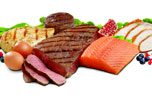
A proper diet is the most overlooked and underrated area in bodybuilding today bar none. I have seen guys agonise for hours over what type of bench press to do, when to take their pre-workout drink, how many reps to do in a set, or what brand of protein supplement to buy, then go out and buy lunch every day of the week wherever they happen to be completely oblivious to the nutritional content of the food. I have said this before but proper nutrition is what separates the men from the boys. Its not fun, doesn’t always taste great and can be pricey but if you are serious about transforming your body then there is no better place to start. So lets take a look at why bodybuilders are constantly discussing their “macros”
What are Macros?
The term Macro refers to Macro-Nutrients. These are the fundamental nutrients necessary for your body and in particular for building muscle. The three macros are:
 Carbohydrates
Carbohydrates
Carbohydrates are the chief source of energy for all bodily functions and muscular exertion. They are necessary for the digestion and assimilation of other foods. They help regulate protein and fat metabolism, and fats require carbohydrates to be broken down in the liver. They also provide some of the structural components necessary for the growth and repair of tissues. All carbohydrates contain 4 calories per gram.

Protein
Protein is one of the basic components of food and makes all life possible. Amino acids are the building blocks of proteins. All of the antibodies and enzymes, and many of the hormones in the body are proteins. They provide for the transport of nutrients, oxygen and waste throughout the body. They provide the structure and contracting capability of muscles. They also provide collagen to connective tissues of the body and to the tissues of the skin, hair and nails. Proteins contain 4 calories per gram.

Fats
Fatty acids are individual isomers of what we more commonly call “fats”. There are potentially hundreds of different fatty acids, but just a few dozen that are commonly found in the foods we eat. Nutritionists commonly classify dietary fat as either saturated, monounsaturated, or polyunsaturated, based on the number of double bonds that exist in the fat’s molecular structure. For each of these three classes, there exists a large number of different chemical variations or “isomers”. These include the EFA’s or Essential Fatty Acids. Fats are required to produce and build new cells. They are a source of energy and are critical in the transmission of nerve impulses and brain function and development. They are also involved in the synthesis of other essential molecules such as hormones. Fats contain 9 calories per gram.
How do we Measure Macros
Macros are measured 2 ways: either as a percentage of total calorie intake or as grams per bodyweight. For example I recommend a macro intake of 50% carbs, 30% proteins and 20% fats for beginners on their first steroid cycle. So if they were aiming for 3000 calories a day it works out to be 375g of carbs, 225g of protein and 67g of fats.
The other method that bodybuilders commonly use is to consume 1-1.5 grams of protein per pound of bodyweight. In the example above I used a 175 pound person so using this method they should consume 175 to 260 grams of protein daily. From there they can work out how many carbs and fats to consume to hit their calorie goals.
(Just remember your fats percentage should not fall below 15%. Fats are essential to hormone development, which is imperative to building muscle.)
Some awesome calculators to help you out:
|
Working it out for you
An important factor in working out your macros is to assess what body type you have. This will help you maximise your muscle building whilst avoiding an abundance of fat to go with it.
There are three general body types, with many people falling somewhere in between. While the endomorph could be considered the polar opposite of the ectomorph, many people are a combination of “endo/meso” or “ecto/meso.” Even if you end up determining you’re somewhere in the middle, these categories are helpful for establishing a nutritional benchmark. Start with the body type you most resemble, and tweak as necessary.
 ECTOMORPH
ECTOMORPH
Ectomorphs are the skinny guys who can’t put on weight. A fast metabolism with smaller shoulders and chest characterise ectomorphs who require a greater percentage of carbohydrates to prevent muscle catabolism, as well as a higher calorie intake overall.
If you’re an ectomorph you want to be upping your carbohydrate intake and possibly even your calorie goals to build solid mass. Gaining fat is almost irrelevant for your body type.
 MESOMORPH
MESOMORPH
Mesomorphs are the middle child of the family. They trend towards being athletic/muscular and should be able to build muscle and burn fat fairly comfortably. If you’re a mesomorph then pretty much all the macro literature is talking about you. You shouldn’t need to adjust macro calculations for your body type but total calories should be monitored to avoid unwanted fat gains.
 ENDOMORPH
ENDOMORPH
The endomorph is the round, soft, stocky body that has a slow metabolism. Gaining weight is like clockwork, but gaining hard muscle without a lot of fat is another story. The endomorph should lower the carbs take and increase the amount of fats and protein in their diet to avoid heavy fat gains. Also your calorie excess should be monitored and subtle and a good rule of thumb is that your protein intake is equal or greater than your carbs intake.
What do other people say:
As with everything in the health industry these days, the science on macros is unsettled with hugely differing opinions appearing everywhere. So here are a few personal opinions from some popular names in the field:
Jay Cutler
(4 Time My olympia Winnner)
- Carbs: 40%
- Proteins: 40%
- Fats: 20%
Kris Gethin
(bodybuilder, trainer and published author)
- Carbs: 35%
- Proteins: 50%
- Fats: 15%
Arnold Swarzenegger
(The Terminator and older brother to Danny Devito – Seriously you should already know)
1lb of body weight = 1 gram of protein
Steve Cook
(IFBB Mens physique competitor and international fitness model)
- Carbs: 40%
- Proteins: 40%
- Fats: 20%
Short Take-Away
There is a bit of info there to digest (pun intended), but here are the takeaways:
- Fat percentage should be over 15%
- Protein intake should be over 1 gram per pound of bodyweight
- Ectomorphs (skinny bodies) require more carbs whilst the opposite holds true for endomorphs
- Each body is different monitor your macros and make changes as necessary to your ratios
- Don’t forget that total calorie intake is still the most important element of your nutrition plan.
My next post is a macro food guide which will list the best sources to make sure you hit your macros. Keep an eye out for it it shouldn’t be far away.